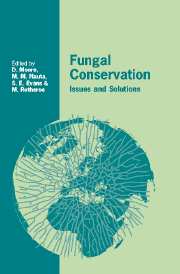Book contents
- Frontmatter
- Contents
- List of contributors
- Preface
- 1 Fungal conservation issues: recognising the problem, finding solutions
- 2 Current trends and perspectives for the global conservation of fungi
- 3 Conservation and management of forest fungi in the Pacific Northwestern United States: an integrated ecosystem approach
- 4 The future of fungi in Europe: threats, conservation and management
- 5 Fungi as indicators of primeval and old-growth forests deserving protection
- 6 Recognising and managing mycologically valuable sites in The Netherlands
- 7 Threats to hypogeous fungi
- 8 Wild mushrooms and rural economies
- 9 Threats to biodiversity caused by traditional mushroom cultivation technology in China
- 10 A preliminary survey of waxcap grassland indicator species in South Wales
- 11 Grasslands in the coastal dunes: the effect of nature management on the mycota
- 12 The conservation of fungi on reserves managed by the Royal Society for the Protection of Birds (RSPB)
- 13 Strategies for conservation of fungi in the Madonie Park, North Sicily
- 14 Fungal conservation in Ukraine
- 15 The threatened and near-threatened Aphyllophorales of Finland
- 16 Fungal conservation in Cuba
- 17 Microfungus diversity and the conservation agenda in Kenya
- 18 Fungi and the UK Biodiversity Action Plan: the process explained
- 19 The Scottish Wild Mushroom Forum
- 20 The contribution of national mycological societies: establishing a British Mycological Society policy
- 21 The contribution of national mycological societies: the Dutch Mycological Society and its Committee for Fungi and Nature Conservation
- 22 Fungal conservation in the 21st century: optimism and pessimism for the future
- Index
13 - Strategies for conservation of fungi in the Madonie Park, North Sicily
Published online by Cambridge University Press: 13 October 2009
- Frontmatter
- Contents
- List of contributors
- Preface
- 1 Fungal conservation issues: recognising the problem, finding solutions
- 2 Current trends and perspectives for the global conservation of fungi
- 3 Conservation and management of forest fungi in the Pacific Northwestern United States: an integrated ecosystem approach
- 4 The future of fungi in Europe: threats, conservation and management
- 5 Fungi as indicators of primeval and old-growth forests deserving protection
- 6 Recognising and managing mycologically valuable sites in The Netherlands
- 7 Threats to hypogeous fungi
- 8 Wild mushrooms and rural economies
- 9 Threats to biodiversity caused by traditional mushroom cultivation technology in China
- 10 A preliminary survey of waxcap grassland indicator species in South Wales
- 11 Grasslands in the coastal dunes: the effect of nature management on the mycota
- 12 The conservation of fungi on reserves managed by the Royal Society for the Protection of Birds (RSPB)
- 13 Strategies for conservation of fungi in the Madonie Park, North Sicily
- 14 Fungal conservation in Ukraine
- 15 The threatened and near-threatened Aphyllophorales of Finland
- 16 Fungal conservation in Cuba
- 17 Microfungus diversity and the conservation agenda in Kenya
- 18 Fungi and the UK Biodiversity Action Plan: the process explained
- 19 The Scottish Wild Mushroom Forum
- 20 The contribution of national mycological societies: establishing a British Mycological Society policy
- 21 The contribution of national mycological societies: the Dutch Mycological Society and its Committee for Fungi and Nature Conservation
- 22 Fungal conservation in the 21st century: optimism and pessimism for the future
- Index
Summary
Introduction
The Madonie Park, covering 40 000 hectares, is one of the most interesting and floristically differentiated areas in the Mediterranean basin. Its territory shows a very high degree of diversity as instanced by about 1600 taxa of the vascular flora with a high percentage of endemic species. The forest vegetation, in the Mediterranean to subatlantic belt, is varied and mainly characterised by evergreen oak (both Quercus ilex and Q. suber) and deciduous woods with Quercus pubescens, Q. virgiliana, Castanea sativa, Q. petraea and Fagus sylvatica. Exotic trees are widespread in all the Madonie mountains, including Pinus halepensis, P. pinea, P. nigra, Cedrus atlantica, C. deodara, Cupressus sempervirens, C. arizonica, C. macrocarpa, Abies alba, A. cephalonica, Robinia pseudoacacia and Eucalyptus camaldulensis. The landscape is also composed of rocky environments, grasslands and wetland sites. All these environments are also very rich in cryptogams (lower plants) but knowledge about them is still inadequate.
As regards fungi, it is noteworthy that since the second half of the seventeenth century the local population has exploited the understorey products as a source of food or for income. In the last decade mushroom picking, previously limited to relatively few people, has become a widespread pastime with potentially adverse consequences to mycelium growth and fruit body appearance. This threat, together with the lack of knowledge of Sicilian fungi, causes serious problems for any attempt to safeguard the integrity of the ecosystem. In addition, the concern for fungi by local authorities and the scientific community is still very slight.
- Type
- Chapter
- Information
- Fungal ConservationIssues and Solutions, pp. 156 - 161Publisher: Cambridge University PressPrint publication year: 2001



